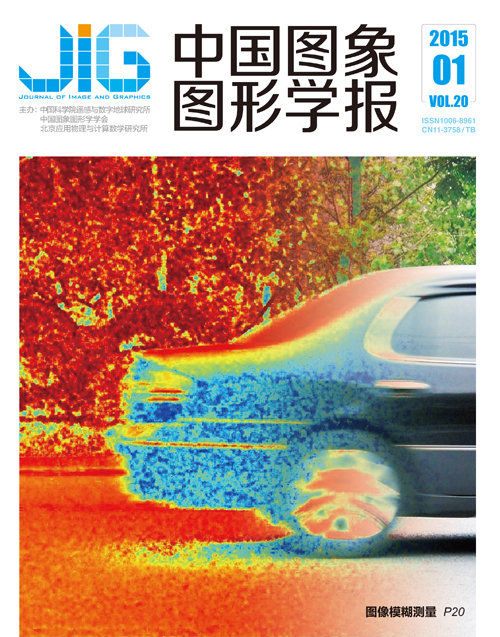
稀疏表示和贪婪搜索的人脸分类
摘 要
目的 随着稀疏表示方法在图像重建问题中的巨大成功,研究人员提出了一种特殊的分类方法,即基于稀疏表示的分类方法。为了加强样本间的协作表示能力以及减弱稀疏分解时的强L1约束,提出了一种在稀疏分类框架下的迭代剔除机制和贪婪搜索策略的人脸识别方法。方法 将测试样本表示成训练样本线性组合的方式,并在所有训练样本中通过迭代计算来消除对分类影响较小的类别和单个样本,在系数分解的过程中采用最小误差正交匹配追踪(EcOMP)算法,进而选择出贡献程度大的类别样本并进行分类。结果 在迭代更新样本字典的过程中,强化了真实类别的表示能力,并弱化了分解系数的强L1约束。在所有的实验中,正则化参数λ的取值为0.001,在ORL、FERET和AR 3个人脸数据库上,本文算法的识别率可分别达到97.88%、67.95%和94.50%,进而验证了本文算法的有效性。结论 提出的在稀疏分类框架下的迭代剔除机制和贪婪搜索策略的人脸识别方法,在动态迭代的机制中完成了样本字典的更新,平衡了协作表示和稀疏约束的关系,相比较原始的稀疏分类模型有更好的准确性和稳定性。
关键词
Sparse representation based face recognition classification algorithm using greedy search strategy
Liu Zi1, Song Xiaoning1,2, Tang Zhenmin1(1.School of Computer Science and Engineering, Nanjing University of Science and Technology, Nanjing 210094, China;2.School of Internet of Things Engineering, Jiangnan University, Wuxi 214122, China) Abstract
Objective The success of sparse representation in image reconstruction triggers the research on sparse representation-based pattern classification (SRC). A strict and standard dictionary creates sparse coefficients, but may not achieve a better classification accuracy in the SRC model. Recent research reveals that the collaborative representation (CR) mechanism, but not the L1-norm sparsity constraint, improves face recognition (FR) accuracy. Therefore, constructing a rational and optimal dictionary for SRC model is a challenging task. We propose a novel SRC fusion method using a dynamical class-elimination mechanism, which strengthens the ability of collaborative representation, and a greedy search (GS) strategy for face recognition. Method The proposed method involves two aspects: training variable selection and classification strategy and sparse coding coefficient decomposition. The training variable selection and classification strategy aims to represent a query sample as a linear combination of the most informative training samples and to exploit an optimal representation of the training samples from the classes with major relevant contributions. Instead of eliminating several classes at one time, we eliminate classes one by one with GS sparse coding process until the ideal number of classes is obtained. In the context of the proposed method, an important goal is to select a subset of variables that can accomplish the provision of a descriptive representation for sparse category knowledge structure. We develop a heuristic learning strategy to achieve this goal. The method converts the original classification problem into a simpler one that contains a relatively small number of classes. The remaining final training samples are used for classification and to produce the best representation of the test sample. Literature validates that the CR mechanism has a significant role in the SRC scheme compared with the sparsity constraint. However, the sparsity constraint cannot be removed from the SRC scheme. We introduce a greedy search method, i.e., error-constrained OMP, to integrate sparsity and CR mechanism and to solve the problem of sparse decomposition. Term regularization has a twofold role. First, it makes the least square solution stable; and second, it introduces a certain amount of “sparsity” to the solution. However, this sparsity is weaker than that by L1 norm. Result The SRC model shows that the test samples are not represented by all training samples, but can be sparsely represented over a dictionary. Therefore, we follow the following two key points: CR mechanism to improve classification and the condition of sparse constraint. For the SRC analysis, a test sample has been represented as a linear combination of all the training samples. The coefficient of a training sample in the linear combination acts as the weight of the training sample. The method assigns the test sample into the class that produces the minimum representation residual. A smaller coefficient denotes that some training samples have fewer contributions. Therefore, these training samples are inconclusive to the classification. The class that has fewer contribution to represent the test sample can be assigned to a zero coefficient, and the linear combination of all the remaining training samples is reassessed. These remaining training samples are informative to exploit an optimal representation of the test sample with major relevant contributions. The proposed method removes only one candidate class from all classes. The removed class is far from the test sample of the linear combination that will represent the test sample during iteration. The classes that are very far from the test sample are first excluded, and the classification decision depends only on the remaining classes. Experiments conducted on the ORL, FERET, and AR face databases have demonstrated the effectiveness of the proposed method, and the recognitions rates are up to 97.88%, 67.95%, and 94.50%, respectively. Conclusion A novel SRC fusion method using hierarchical multi-scale LBP and greedy search strategy is developed. The method aims to establish a heuristic iterative algorithm to obtain the supervised sparse representation of the test sample and then exploit an optimal representation of training samples from the classes with major relevant contributions. This method involves two aspects: dynamical class-elimination mechanism and replacement of the sparse approximation problem by a greedy search strategy. The test sample is classified into a class whose contribution has the minimum error. In this method, the sparse factors exerting influence on the structure knowledge can be incorporated into the sparse representation via iterative measurement of sparsity constraint. Experimental results show the feasibility and effectiveness of the proposed method. This type of sparse learning method is a new attempt compared with traditional popular representation methods in image recognition and can be clearly interpreted and be successfully applied in classifications. Future work can place emphasis on the quality of dictionary leaning. A study on the effect of introducing fuzzy weights into each atom will give them a varying fuzzy degree of popularity.
Keywords
|



 中国图象图形学报 │ 京ICP备05080539号-4 │ 本系统由
中国图象图形学报 │ 京ICP备05080539号-4 │ 本系统由